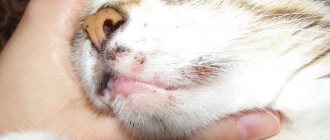What is demodicosis
Subcutaneous mites under a microscope
Demodicosis in cats is caused by 2 types of microscopic mites: Demodex cati and Demodex gatoi. The first lives in hair follicles and adjacent tissues, the second - in the superficial layers of the skin. The size of the parasites does not exceed 0.5 mm; they can only be seen under microscope magnification. The transparent body is supported on legs with hooks, the oral cavity looks like a proboscis. This parasitic disease affects the cat's skin and hair.
Demodex develops in the body of one carrier and dies in the external environment after 2 hours. An adult gnaws through the epidermis, penetrates the hair follicle, where it feeds on cell breakdown products, sebum and reproduces.
From the egg to the mature individual, the tick passes through the stages of larva, protonymph and deutonymph. The parasite develops in both active and passive forms: in the first it feeds and grows, in the second it becomes motionless. The biological cycle lasts 20–25 days; in 3 months, at least 3 generations of mites develop in the cat’s body.
Symptoms of the disease
The disease in its pure form is very rare. As a rule, it is accompanied by pathologies of infectious, fungal or allergic origin. In this case, the signs of the disease are somewhat blurred.
Externally, demodicosis does not appear immediately. It takes time for the mite to reproduce and spread, making it almost impossible to identify the affected area of skin. If the disease is not detected early, your pet can suffer greatly.
The first signs appear on the muzzle and surface of the head. Usually the disease is accompanied by the following symptoms:
- the appearance of balding areas in the affected area, which cause severe itching and cause anxiety;
- the hair in the back of the head becomes hard, faded and tousled;
- redness of the skin, which is accompanied by peeling and the formation of small scales resembling dandruff;
- the skin becomes uneven and bumpy, covered with small papules filled with a cloudy liquid;
- thickening of the skin and the formation of folds and scabs;
- “demodicosis glasses”: hair loss, narrowing and redness of the eye shape;
- enlarged lymph nodes in the affected area.
In the absence of timely treatment, the cat develops fungal or pustular dermatitis, the deep layers of the skin and hair follicles become inflamed. Over time, the skin becomes sticky and a putrid odor begins to emanate from the pet.
The onset of the disease is reflected in the behavior of the pet. The cat becomes restless and tries to lick the damaged areas. In this case, ingestion of fur occurs, which disrupts digestion and provokes vomiting. Due to frequent licking, exposed skin areas turn red. This may cause the development of a fungal or bacterial infection.
Causes of infection
A cat of any breed and any age can get demodicosis. However, a microscopic mite, having entered the animal’s body, may not manifest itself for a long time (until the right moment comes), and the cat becomes a carrier of the parasite. When the cat is in normal condition, the tick “sleeps”, but when immunity decreases, demodicosis worsens, and the tick begins to secrete waste products that poison the cat’s body.
It is known that Burmese and Siamese cats are particularly susceptible to mange, but other animals may also be at risk:
- cats that have recently had surgery;
- pets who have recently suffered from an infectious disease;
- animals infected with worms or fleas;
- cats and kittens in a state of severe stress;
- animals that are not eating properly (for example, if the cat receives too little protein during natural feeding);
- cats that have recently been treated with antibiotics or hormonal drugs.
The main reason for the development of the disease is considered to be a decrease in the cat’s immunity, as a result of which the tick takes a pathogenic form and begins to actively multiply in the epidermis of the animal. Very often the disease is registered in small kittens after weaning them from their mother.
Causes of the disease
The causative agent of cat scabies is the demodex mite. It lives on the skin of cats. By feeding on dead skin particles and sebum, it cleanses them of impurities. Strong immunity prevents the parasite from harming the cat’s health.
When the natural defense weakens, the tick becomes active. This may happen for the following reasons:
- chronic diseases of the stomach and intestines;
- pathologies of the hematopoietic system;
- diabetes;
- colds and infectious diseases;
- changes in the composition of subcutaneous sebum and pH of the skin;
- use of antibiotics and non-steroidal anti-inflammatory drugs for the treatment of chronic diseases;
- genetic predisposition;
- helminthic infestations;
- damage by ectoparasites - fleas or lice;
- poor quality nutrition, lack of fats and animal proteins in the diet;
- lack of vitamins A, E, B in the body;
- frequent stress;
- keeping in a dirty room, dirty bedding.
Routes of infection
A cat can become infected in several ways:
- in contact with a sick animal (for example, on the street);
- when kittens communicate with their mother (kittens can become infected);
- through common hygiene items or things (for example, if a sick animal came into contact with your cat’s leash);
- intrauterine infection (extremely rare).
Most often, this disease is detected in cats under 2 years of age, elderly and emaciated animals.
Interesting! For a healthy person, demodicosis is completely safe. Despite the fact that people also suffer from demodicosis, the tick that parasitizes the animal’s body does not pose a threat to humans. In humans, demodicosis is caused by a completely different type of parasite. Despite this, some people (especially those with weakened immune systems) may want to avoid contact with a sick cat.
Types and forms of demodicosis
Veterinarians distinguish three types of the disease and two varieties.
Types of Feline Mange
There are three types of demodicosis. This :
- Localized form . The disease is characterized by a mild course. Most often occurs in young cats under 2 years of age. Accompanied by the development of the following symptoms: the appearance of dry scales on the surface of the skin, a few focal rednesses indicating the site of the bite. The paws and back of cats are rarely affected. The pathology tends to self-heal within one to two months after the onset of development.
- Generalized demodicosis . The symptoms of the disease are pronounced. The cat’s skin is severely inflamed, ulcers, bleeding wounds, etc. appear on it. The muzzle, head, and neck are the first to be affected. The back and paws are next. This form of demodicosis is characterized by rapid development: a fusion of pathological foci is observed, accompanied by damage to the entire surface of the skin.
- Juvenile type . It develops as a result of a hereditary predisposition to demodicosis and occurs in a severe form. The disease is especially dangerous for cats because it leads to the complete destruction of the animal’s immune defense. A favorable prognosis is possible only with early treatment.
Varieties of demodicosis
There are two types of feline mange:
- Primary demodicosis . The disease develops against a background of weakened immune defense. The mite invades the area of the sebaceous glands and hair follicles. The bite area is a hard lump covered with scales. When pressure is applied to its surface, a white liquid is released containing a large accumulation of parasite eggs and its metabolic products.
- Secondary demodicosis . The pathology is formed against the background of an existing skin disease.
The signs of the disease, regardless of the type - primary or secondary form of scabies was diagnosed in a cat - are identical. The surface of the skin in the affected area becomes hard and uneven, and characteristic cracks are clearly visible. The animal emits an unpleasant sour odor.
The cat quickly loses weight because it loses its appetite. Signs of exhaustion appear. Inflammation of the lymph nodes is observed.
© shutterstock
Symptoms of demodicosis in cats
There are three forms of demodicosis:
- Localized is a simple and obvious form of the disease that spreads only to one or several parts of the pet’s body. Under this condition, there is no infection of the paws. Treatment will take several weeks, the pet will recover quickly.
- Generalized - an advanced form of the localized type. If left untreated, the disease will begin to affect all areas of the skin, starting from the paws, ending with the side and genital area. It occurs more often in street animals that have no one to look after them. It is extremely difficult to cure, since immunity decreases and against the background of one disease several more appear.
- Juvenile - inherited, a very dangerous form of demodicosis, because the immune system is destroyed.
Demodectic mange in cats - localized form
It is believed that the generalized form of scabies is much more severe than the localized one. Some veterinarians even recommend that owners of sick cats sterilize their pets, as there is a risk of transmitting the tick “by inheritance.” Symptoms of demodicosis can appear gradually, one after another, so the owner may “miss” the localized form of the disease.
If you notice any symptoms, you should immediately contact your veterinarian:
- itching of the animal's skin, its redness;
- acne, nodules, and purulent pimples begin to appear on the skin;
- wounds on the skin, which may contain a small amount of blood or simply become wet;
- deterioration of the animal's fur - dull, dirty, prickly;
- “demodicosis glasses” - hair falls out around the eyes and the skin peels off;
- hair falls out on the body, if the localized form is on the head, neck, ears. If generalized - along the body and on the paws;
- violation of pigmentation of the skin of the animal’s body;
- in the generalized form, the work and functioning of the pet’s internal organs is disrupted; this can lead to lack of appetite, weakness, apathy, etc.
Diagnosis and treatment
Pet owners should understand that at the first sign of illness they should immediately contact a veterinarian. Scratching and hair loss should never be ignored. An advanced disease can lead to a complete refusal to eat, decreased immunity, and blood poisoning.
At the vet
At the veterinary clinic, the doctor will take a scraping from the damaged area of the skin, identify the causative agent of the disease and prescribe treatment.
By treating demodicosis at home, the owner must achieve the following results: restore the animal’s immunity and get rid of the excess number of mites.
The veterinarian usually prescribes a complex of medications, combining the use of ointments, injections, sprays, and immunomodulators.
Veterinarians prescribe the following medications:
- Injections against ticks – Amirtrazine, Baymek, Ivermectin ,
- For treating diseased areas of the skin - solutions of Neostomazan, Butox, Chlorhexedine. You can use hydrogen peroxide , which disinfects the skin and cleanses it of crusts,
- Inflammatory processes are alleviated with the help of Aversectin ointment and Demos liniment,
- Solutions with an oily consistency may be recommended to soften the skin. These include - Mikodemotsid, Amit, Tsipam ,
- To soften the skin, you can use natural healthy oils, such as sea buckthorn or fir.
- To strengthen the body, drugs are used - Immunoparasitan, Immunol, Maxidin .
It must be remembered that the use of medications according to the regimen prescribed by the veterinarian is the key to successful treatment of your pet.
Veterinarians do not recommend simultaneous treatment with corticosteroids and hormonal drugs.
During treatment, the pet must be isolated from other animals, the house and scratching post must be disinfected, and sleeping mats must be burned.
Baymek
- With a localized form of demodicosis, it is possible to quickly treat the inflammation process. You should be wary of a recurrence of the disease, which will require antibiotics.
- In the case of a generalized form of the disease, a course of treatment is prescribed not only for demodicosis, but also for the factors that led to its complicated course.
Diagnostics
When making a diagnosis, it is important not to confuse this disease with similar diseases in cats, such as ringworm or dermatitis. Therefore, the veterinarian pays attention not only to external symptoms, but also conducts diagnostics in the laboratory.
To do this, you need to take a sample of the affected skin and carefully examine it. In severe cases, scraping reveals the presence of parasites that are at different stages of development, namely eggs, larvae and mites. If only adult individuals are found during scraping analysis, then the carrier is considered safe for other animals. In addition to obtaining a scraping, they may take a swab sample from the ear, which is examined using a microscope.
Treatment of demodicosis in cats is prescribed by a doctor after an external examination and study of test results. It happens that in order to detect a tick it is necessary to take scrapings several times from different parts of the animal’s body. If your cat licks itself thoroughly, you can find ticks in its feces, which will help with diagnosis. Provided that the cat does not have external symptoms of demodicosis, it is also advisable to undergo tests to exclude the presence of a tick.
Prevention
Prevention of demodicosis in cats is the only way to protect your pet from an unpleasant disease. Healthy cats with strong immune systems rarely get scabies.
Close attention should be paid to maintaining the pet's immunity. To do this, first of all, it is necessary to provide him with adequate nutrition. When choosing cat food, you should carefully analyze its composition, choosing the highest quality.
Another effective preventive measure is proper cat care. That is, treatment for parasites, regular combing. Contact with potentially infected animals should be avoided.
The best prevention would be the use of drugs against demodicosis: Immunoparasitan serum (once every six months), antiparasitic drops (once a month).
To ensure your cat remains healthy and active throughout its life, you should visit your doctor regularly. Timely diagnosis will protect not only from scabies, but also from more serious diseases.
Treatment
Demodicosis in cats is a generalized form of
“Ugh, what a scary cat, don’t touch him, he’s contagious,” this is what they say about animals with signs of lichen or the presence of ticks. Bald spots on the body, wounds and dandruff cause disgust and sometimes horror in people (see photo). Such cats feel hostility from people and lose faith in recovery. Demodicosis is one of those diseases that disfigures the appearance of even the most beautiful cats. But any disease can be treated, the main thing is to do it correctly.
Some owners, noticing that the cat is feeling better, stop paying attention to the possible illness. Inflammatory processes may subside (remission), but this is a temporary phenomenon. If the owner does not take action, the tick will make itself known again, but it will be a more severe form of the disease.
Preventive measures
To minimize or completely eliminate the risk of infecting a domestic cat with scabies mites, it is necessary to follow some measures to prevent demodicosis.
First of all, you need to create a complete, balanced menu for feeding your four-legged friend. A healthy diet strengthens the immune system, which already reduces the likelihood of parasitic infection.
It is also important to regularly treat the wool with special products against fleas and other microscopic individuals that contribute to the development of unpleasant skin diseases.
In the autumn-spring period, it is advisable to strengthen the cat’s immunity with vitamin and mineral complexes. These same drugs are especially relevant for weakened, often sick animals.
They are selected on an individual basis, so it is not recommended to prescribe vitamin therapy to your cat on your own. It is better to consult an experienced veterinarian and purchase effective products for their intended purpose.
Do not allow your cat to come into close contact with street representatives whose condition causes you some suspicion. And remember, any disease is easier to prevent than to cure, so do everything possible to prevent your furry pet from becoming infected with demodicosis.
Useful tips for pet cat owners
- For antiparasitic treatment of wool, use only formulations intended for cats. Under no circumstances should you use products for dogs; they are more toxic and very dangerous for representatives of the feline family.
- It is not advisable for a pet owner to pet or have close contact with street animals without protective gloves. Parasite eggs may remain on your hands, so when you return home, you may accidentally infect your pet cat.
- During treatment for demodicosis and after the treatment course, continue to follow preventive measures and be sure to provide your pet with a proper and healthy diet. Healthy food will allow the animal to recover faster from illness.
- Antihistamines can be used periodically to prevent infection. Such medications can only be given to an animal with the permission of a veterinarian.
- Scabies mites quickly die in a dry environment, so in treatment it is necessary to use effective means that quickly dry the epidermis. If you find a wound or sore on the animal's skin, treat it with hydrogen peroxide. This product is absolutely safe for animals.
- If your cat begins to itch frequently, conduct a thorough examination of its body and head. If any suspicious signs are detected, an immediate visit to a veterinary clinic is recommended.
- Carry out treatment for demodicosis strictly as prescribed by your doctor. Before giving your cat any product, carefully read the instructions for use. Observe the dosage and interval between doses. Only a responsible approach to treating an animal will ensure a positive result.
Preventive actions
You can protect your animal from an unwanted parasite even at the stage of carrying out preventive measures. What veterinarians advise you to do:
- If a pregnant cat is sick, you should not use antibiotic treatment. The kittens will be born weak and most will die within the first month. After birth they need to be separated;
- if the cat leads a semi-stray lifestyle, which is quite normal for those who live in a private house, a minimum inspection should be done daily. Since the ears often suffer, the best way to protect against the development of diseases is to wipe the ears with chlorhexidine. Wounds received in battle should be treated with hydrogen peroxide and brilliant green;
- Shampoos, sprays and flea collars are no less effective. To prevent the pet from being endangered, it is treated with Stronghold once every 2 months. This is the cheapest and most effective remedy, applied strictly to the withers and distributed along the spine;
- treatment for worms;
- pay attention to the general well-being of the animal. The first sign of illness is loss of appetite and impaired concentration. The cat becomes less active and apathetic, many begin to look for a place where they can hide.
The pet's immune system will not fail if the cat is kept according to all the rules. She should eat well and live in a clean and dry house. A cat should not be left alone for a long time, because many animals suffer from loneliness, become depressed, and eventually get sick. If your cat has company (another cat or dog), then the sick individual needs to be isolated. Let it be a separate room, and sometimes you can take healthy animals, for example, to relatives.
To avoid passing ticks to your pets with your own hands, you need to take care of your hygiene. After each contact with a sick cat, you need to wash your hands and treat them with an antibacterial solution. The clothes you were wearing at the time of contact should be washed immediately. While your pet is sick, limit his access to the outdoors. There have been cases when cats with a frightening itchy “mask” on their faces suffered at the hands of people. Cats that were mistaken for being highly contagious were stoned and abused. Therefore, let your pet heal and get stronger first.
Demodectic mange in cats is a fairly common phenomenon. However, there is no need to panic; the first thing experts recommend doing when a rash appears is to contact the nearest veterinary center. Home medicine is powerless in this case.
For whom are ticks dangerous?
There are many varieties of subcutaneous mites, so absolutely all furry animals are at risk. There is also a species that “specializes” exclusively in humans. However, this does not mean that a person cannot become infected with a cat parasite, and a cat cannot pick up a human one. Although such an “exchange” occurs quite rarely.
It is generally accepted that a cat with demodicosis is safe for humans. This is partly true. The immune system of a healthy person is strong enough to fight off this type of parasite.
At risk are those people whose immunity is weakened, especially those infected with HIV.
Among cats at risk are the Burmese breed, as well as Siamese cats. However, any cat that comes into contact with an infected animal, or simply has access to free walks, can become a victim of demodicosis.
Good immunity of your pet and regular vaccination will help you avoid infection.











